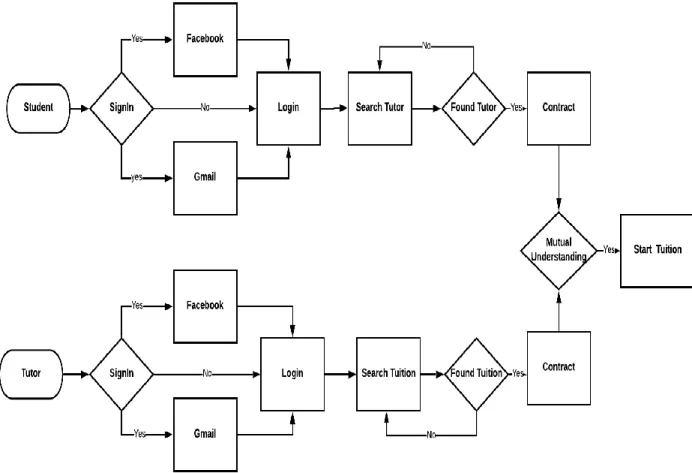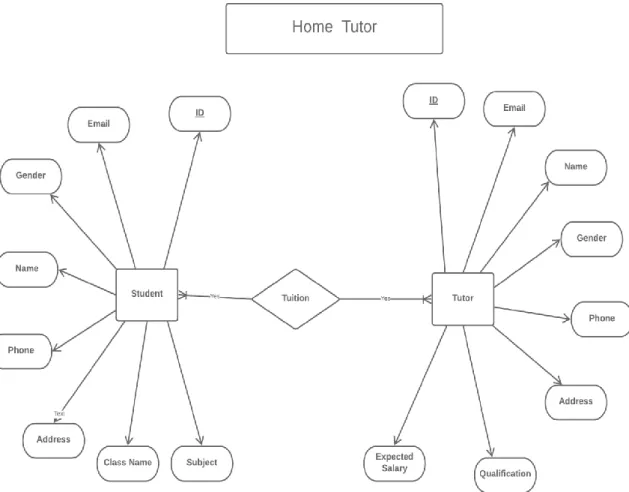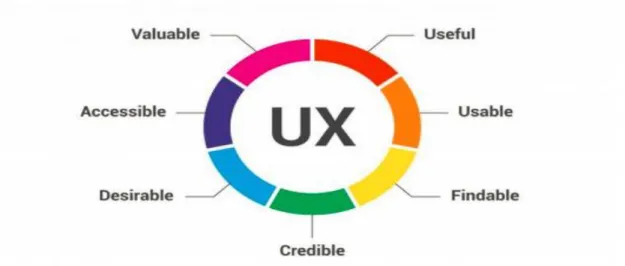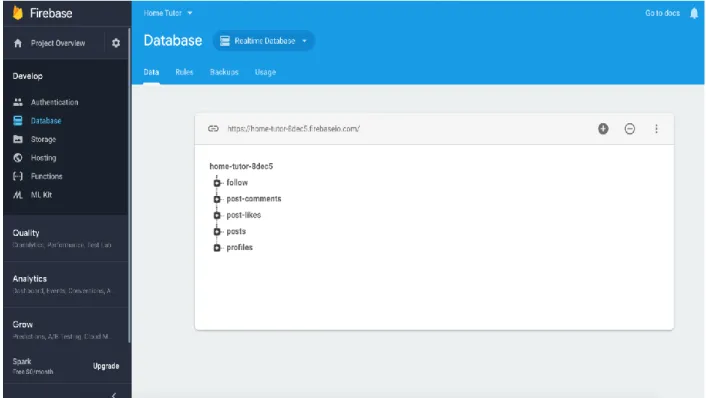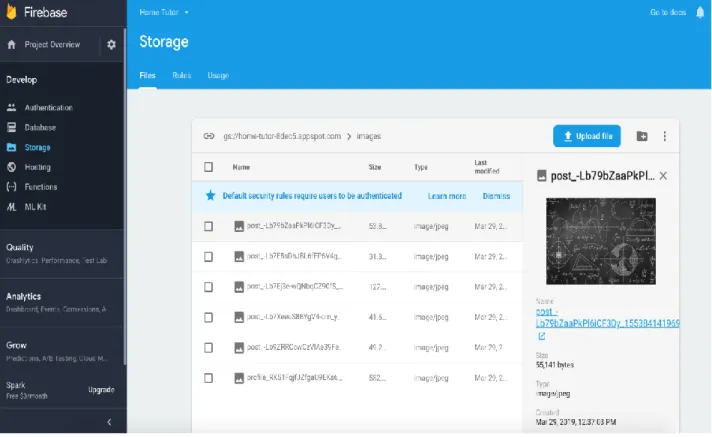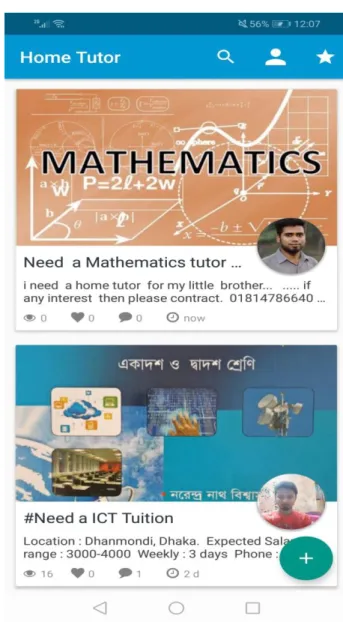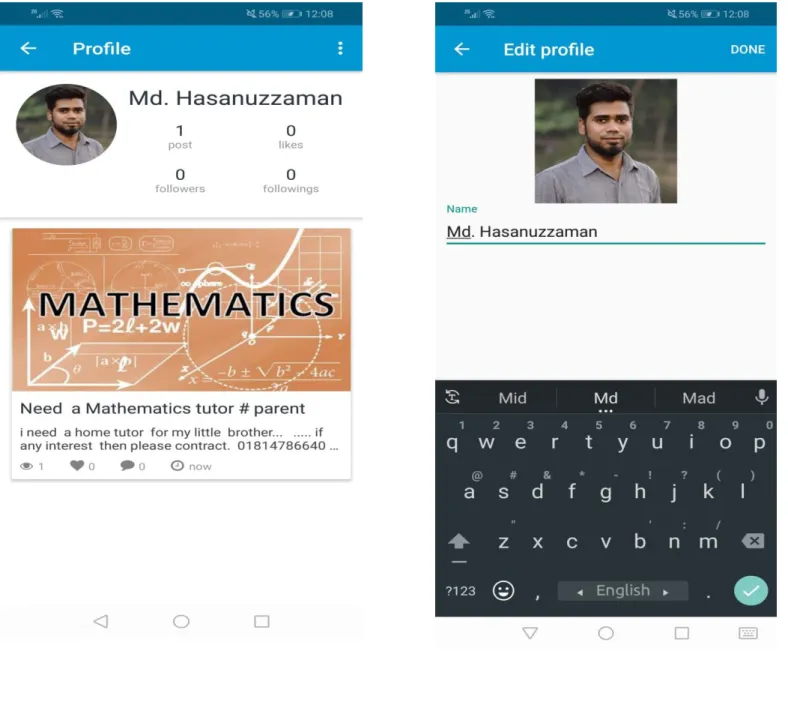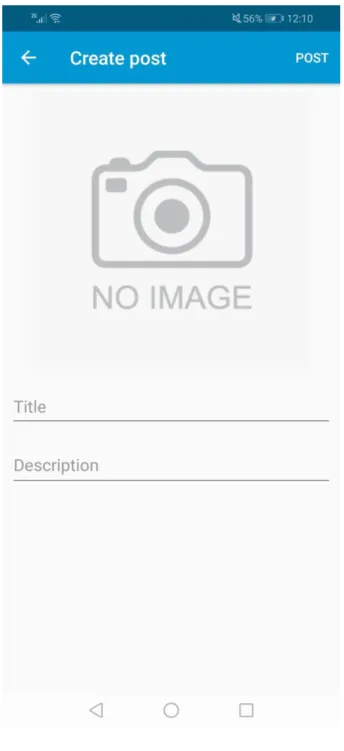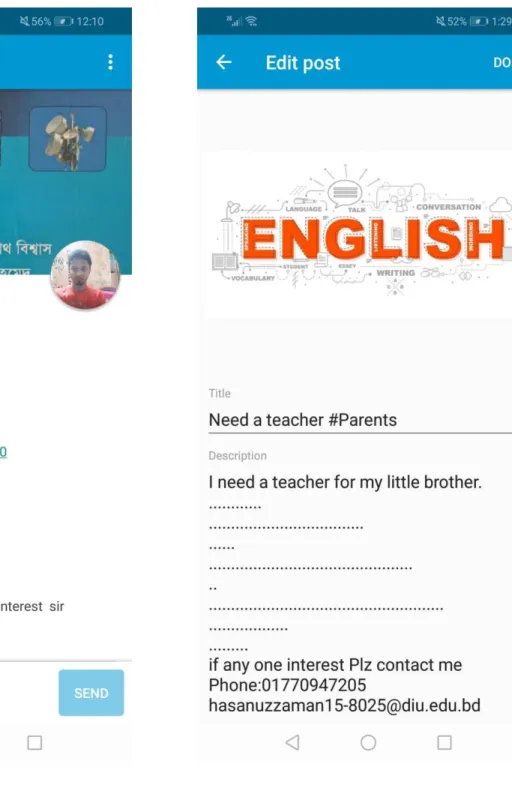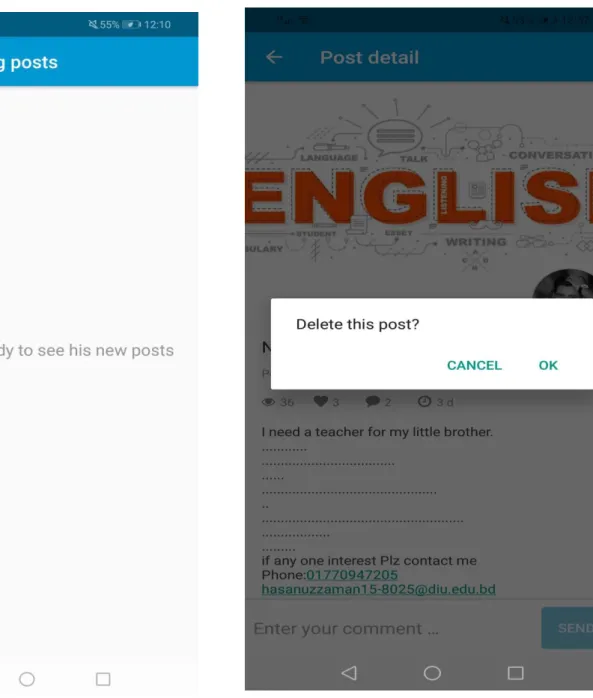HOME TUTOR: An Android Based Mobile Application
BYMD. HASANUZZAMAN ID: 162-15-8025 MUIN MAHMUD
ID: 162-15-7983 AND
MD. MONIR HOSSAIN ID: 162-15-8033
This Report Presented in Partial Fulfillment of the Requirements for the Degree of Bachelor of Science in Computer Science and Engineering.
Supervised By Anup Majumder
Lecturer Department of CSE
Daffodil International University
Co-Supervised By Ahmed Al Marouf
Lecturer Department of CSE
Daffodil International University
DAFFODIL INTERNATIONAL UNIVERSITY
DHAKA, BANGLADESHMay, 2019
ACKNOWLEDGEMENT
First, we express our heartiest thanks and gratefulness to almighty ALLAH for his divine blessing makes us possible to complete our final year project successful. But there are others, without their support, encouragement and appreciation we would not be able to bring our project into light of success. We, from the core of our heart, want to thank them all.
We want to thank our honorable Supervisor Anup Majumder, Lecturer, Department of Computer Science & Engineering, and Daffodil International University. Deep knowledge and keen interest of our supervisor in the field of “Android Application Development” ,to carry out this project. His endless patience, encouragement, expert advice and above all his friendly behavior towards us have made it possible to complete this project.
We would like to express our heartiest gratitude toDr. Syed Akhter Hossain, Professor and Head, Department of CSE, for his kind help to finish our project and also to other faculty member and the staff of CSE department of Daffodil International University.
Next, we must thank and acknowledge our university, Daffodil International University. We also want to thank our beloved classmates and other students of the university who took part in research purpose for our project and appreciated our work.
Lastly, we want to thank our beloved families, who were always by our side and kept faith on us. Without our family support, we could never be here; we cordially thank them for this. We also thank our friends for their support and help to us.
ABSTRACT
This project is based on tutor and student communication system. This project aims to create an easy, faster and smooth communication system between the tutors and the students. This project also offers some opportunities that will help both the tutors and the students on their educational purpose. So, for the better communication system we developed our project that will help the users a lot. This project will boost the confidence of the students in studying, communicating and so on. Mostly students are not willing to waste their valuable times, or a large number of students just feel shy or some introvert to talk to their respective teachers. In this case home tutor can helps students. Because of home tutoring is a form of tutoring that occurs in the home. Tutoring is receiving guidance or instruction by a tutor. Most often the tutoring relates to an academic subject or test preparation. This is in contrast to tutoring centers or tutoring provided through after-school programs. The service most often involves one-on-one attention provided to the pupil; otherwise, is called small group tuition, in which the tutor and a small number of pupils gather at one of their homes for tutoring. our project will bring a smart solution for them. Our projects recreate the whole system online but it will help the users offline too. It will save time and students mustn’t have to worry about their study problems. This system is make and supervised by the experts and satisfying by the students and tutor. XML, JAVA, Firebase, Android Studio are used to develop the system.
This system is tasted by over 5 tutors and 100 students, and 80% of them found the system useful.
TABLE OF CONTENT
CONTENT PAGE
Board of Examiners i
Declaration ii
Acknowledgements iii
Abstract List of Figures
iv vii
CHAPTER
CHAPTER 1: INTRODUCTION
1-31.1 Introduction 1
1.2 Motivation 1
1.3 Objectives 2
1.4 Expected Outcome 2
1.5 Report Layout 2
CHAPTER 2: BACKGROUND
4-62.1 Introduction 4
2.2 Related Works 4
2.3 Comparative Studies 5
2.4 Scope of the Problem 5
2.5 Challenges 6
CHAPTER 3: REQUIREMENT SPECIFICATION
7-183.1 Business Process Modeling 7
3.2 Requirement Collection and Analysis 8
3.3 Use Case Modeling and Description 9
3.4 Logical Data Model 17
3.5 Design Requirements 18
CHAPTER 4: DESIGN SPECIFICATION
19-204.1 Front-end Design 19
4.2 Back-end Design 19
4.3 Interaction Design and UX 19
4.4 Implementation Requirements 20
CHAPTER 5: IMPLEMENTING AND TESTING
21-315.1 Implementation of Database 21
5.2 Implementation of Front-end Design 23
5.3 Implementation of Interactions 30
5.4 Testing Implementation 30
5.5 Test Results and Reports 31
CHAPTER 6: CONCLUSION AND FUTURE SCOPE
32-326.1 Discussion and Conclusion 32
6.2 Scope for Further Developments 32
REFERENCES
33APENDIX
Appendix A: Project Reflection 34
PLAGIARISM
Plagiarism Report
35
LIST OF FIGURES
FIGURESFigure 3.1 Business Process Modeling of Home Tutor
PAGE NO 7
Figure 3.2 Use Case Modeling of Home Tutor. 9
Figure 3.3 Logical Data Model of Home Tutor. 17
Figure 4.1 UX Of Home Tutor 20
Figure 5.1 Firebase Connection 21
Figure 5.2 Firebase Storage 22
Figure 5.3 User Sign In & Home Screen 23
Figure 5.4 User Profile & Edit Profile 24
Figure 5.5 Create Post & Post by Parent 25
Figure 5.6 Post by Tutor and Edit Post 26
Figure 5.7 Post Comment and Complain Post 27
Figure 5.8 Follow Post & Delete Post 28
Figure 5.9
Sign Out 29
CHAPTER 1 INTRODUCTION
1.1 Introduction
A Home Tutor is a one kind of teacher, who provides assistance or tutelage to one or more people on certain subject areas or skills. The tutor spends a few hours on a daily, weekly, or monthly basis to transfer their expertise on the topic or skill to the student. Tutoring can take place in different settings, such as comment’s, chat, a formal tutoring center, or the home of the tutor or learner. As a teaching-learning method, tutoring is characterized by how it differs from formal teaching methods on the basis of the (in) formality of the setting as well as the flexibility in pedagogical methods in terms of duration, pace of teaching, evaluation and tutor-tutee rapport.
1.2 Motivation
The motivation to work in this project is actually our real-life experience. As a student we face many difficulties in our study. We also need guidance to build a good career. Tutors can help students a lot to continue their study life and to build career. So, communication with teachers is very much important for a student. But the problem is to get teachers when they are free as they have a lot of work to do. Though, teachers have counseling hour for students but they may not be available for some important work like meeting, seminar or some personal issues. Sometimes teachers don’t receive anonymous phone calls or cannot receive the call for some reason. Then the student can’t freely share their problems to teacher. This situation motivates us to make an android app to communicate with the tutors and students.
Using the app students can find their useful tutors and make a post to find tutor/student as per need.
1.3 Objective
The main objective of this project is to build a platform where student and tutor can communicate with each other.
Home tutors provide one-on-one attention
They can work on learning easily
Student can easily share problems
Home Tutor teach them more than the syllabus
Student get a flexible and convenient space
A Home Tutor can help your child have goals, objectives and dreams
Any time answer to students’ questions by online chat
1.4 Expected Outcome
The outcome of this project is very simple but important. Some points are mentioned below
Using this app, tutors can manage their tuitions and student can easily find their expected tutors. It will remind them of their works to be done. Students can also compare tutors using the app.
Develop systematic methods for learning from problem sets, including: how to apply and transfer conceptual knowledge; identify common obstacles and errors; and contextualize individual problems within the themes and concepts of the course.
Creating groups tutors will be able to contact with a group of students. Using notification tutor will let students know about their upcoming tutors.
1.5 Report Layout
We developed an application which name is “Home Tutor”. We make sure that the project complete in time. Respect to our workflow we design our project report.
In chapter 2 named Background discuss about the Introduction, Related Works, Comparative Studies, Scope of the Problem, Challenges.
In Chapter 3 named Requirement Specification we discuss about the Business Process Modeling, Requirement Collection and Analysis, Use Case Modeling and Descriptions, Logical Data Model, Design Requirements.
In chapter 4 named Design Specification we discuss about the Front-end Design, Back-end Design, UI Design and UX and Implementation Requirements.
In chapter 5 named Implementation and Testing we discuss about the Implementation of Database, Implementation of Front-end Design, Testing Implementation, Test Results and Reports.
In chapter 6 named Discussion and Conclusion we discuss about the Future Scope, Discussion and Conclusion of the whole project.
CHAPTER 2 BACKGROUND
2.1 Introduction
Communication between teacher and student is very much important in teaching process. As teachers are the best guide of the students, students have to communicate with teachers. Not only about study but also a good career and future plan students have many questions in their mind. Students face problems everyday while they are study or do some work related to study or their career. To know the answers of their questions or to find the solutions of their problems students go to their teachers first. This is why communicating with teachers is so important. On the other hand, teacher may need to contact a student or a group of students or some reason. A medium or media that is fully dedicated for teachers and students can help both tutors and students to communicate with each other.
2.2 Related Works
There are some applications available related to this project but no one is totally similar.
Some of the applications that are similar are mentioned below.
To tell about related works which name come first is Google Classroom. It is only available for teachers and students of an educational institute that has provided Google apps for Education account. Teachers can create classroom here and students join in the classroom using classroom code. Teacher can post Announcement for selected students or for all students. Teacher also can give individual Assignments in classroom.
Another app that is very similar is Buzz Mob. It is a communicating app among teachers, students and parents. Joining school or classroom a user can send or receive message, share photos, videos or other files. It sends important notifications about assignments, event dates or general updates. BuzzMob.com account is needed for a school or classroom to use this service.
There is a school messaging app that is named Remind. It provides real time messaging to the users. Remind also allows users to add reminder. Using Remind it is possible to send text messages to any phone.
There are other apps to help teacher organize classes, manage student information like attendance, grade etc. Teacher Kit, Teacher App & Grade Book are this kind of app. There are also some class scheduler apps available in Play Store like My Class Schedule:
Timetable, Teacher Schedule, Class Schedule etc.
2.3 Comparative Studies
There are a lot of communication systems [1] currently available now. By using those both teachers and students become beneficial. Every educational institute especially the universities have their own strategy to communicate with their teachers and students. As the world is going faster so there is always a hunger to communicate faster and effectively. But still now in the age of internet, we are still looking for a platform that makes us comfortable to communicate.
So that we wish to offer such a communication system that will help us a lot. Using one communication platform is more comfortable than using three or four communication platforms. As internet reach everywhere, we can easily interact with everyone anytime, anywhere they live. In this competitive world we will say that, our system will keep people together and save their valuable time too.
2.4 Scope of the Problem
As we said, teachers and students face some difficulties to communicate with each other. Our current communication system isn’t as fast as the demand is going. So, we can discuss some problems here;
Using android development platforms may not be suitable for every student or tutor.
There is some manual system to communicate, but this is fully online based.
Sometimes students face to share some information face to face with their respected teachers.
According to these problems, our application offers solutions that will help both the teachers and students no doubt. We will look after this from two perspectives; one with the students and another with the teachers.
For students, helps
1. To get communicate faster 2. To select study plan with tutor
3. Easy option to make a question to the tutor 4. Get alarming before every task
5. Stay up to date
For tutors, helps
1. To inform students easily 2. Reduce the work pressure 3. Smart way of communication
2.5 Challenges
Every work has some challenges. As communication is our main purpose so we have to face several challenges too.
1. As it’s an android based mobile application, so if a student doesn’t have an android phone then this app will not help him.
2. After getting notification’s if a user doesn’t check his phone for full information then the main motto of this app will be failed.
CHAPTER 3
REQUIREMENT SPECIFICATION
3.1 Business Process Modeling:
BPM or Business Process Modeling is a process [2] of constructing a structural view of a system or process. It includes some process, starts and symbol, condition as like a flow chart. In this process we can see the student can send request to a teacher to show that the student is interested to take tuition from that tutor. And again, the same system goes for the tutor, if the tutor likes a student then the tutor can send request to the student to show that the tutor is interested to teach that student.
Figure 3.1: BPM of Home Tutor
3.2 Requirement Collection and Analysis
When we are working on a project, a delivery time of the project has already given. That’s why project works must be planned and executed to deliver timely with the solutions that are both relevant and realistic to the project problem.
Our project is an online based tutor and student communication system. So, the process of collection requirements must incorporate and address all the realities. It’s because to identify the requirements at all levels and perceptions [3].
Software Requirements:
Students
Log in system for the tutors
Log in system for the students
Time convenience
Easily accessible
Hardware and Software Requirements for our system:
Whenever you purchase software or hardware for your computer, you should first make sure your computer supports the system requirements. These are the necessary specifications your computer must have in order to use the software and hardware to be used efficiently; all computer software needs certain hardware components or other software resources to be present on a computer [4].
In development stage the system requires for all tools and platforms describe to advance the new system like.
XML
JAVA
Android Studio 3.0
Firebase Database.
3.3 Use Case Modeling and Description:
A use case model is a graphic description of the interactions among the elements of a system. A use case is a methodology used in system analysis to identify, clarify and organizing system requirements [5].
Use Case Description of Home Tutor Use Case:
Sign-InActor:
StudentPre-condition:
NULLPrimary Path
Choose sign in as student
Fill the data fields
Click the registration button
Take to the home page
Alternate Path
Didn’t choose sign in as student
Data field is empty
Connection error
Post-condition
If sign-in successful
If home page is loaded
Use Case: Student Login
Actor:
StudentPre-condition:
Sign-InPrimary Path
Choose sign in
Fill the data fields
Click the log in button
Take to the home page
Alternate Path
Didn’t choose sign in page
Data field is empty
Connection error
Post-condition
If sign-in successful
If home page is loaded
Use Case: Post Actor: Student
Pre-condition: Login Primary Path
Add post
Delete post
Alternate Path
Didn’t any post
Connection error
Post-condition
If post was loaded
Use Case: Search post
Actor: Student
Pre-condition: Login Primary Path
Choose search button
Type subject or tutor name
Alternate Path
Didn’t choose search button
Didn’t typed subject or tutor name
Typed wrong type of search
Connection error
Post-condition
If search is successful
Use Case: Can Discuss with Problem
Pre-condition: Login Primary Path
Find problem
Click on the post
Alternate Path
Didn’t solve problem
Didn’t click on the post
Use Case: See Tutor details
Actor: Student
Pre-condition: Login Primary Path
Find the tutor
Click on the tutor profile
Alternate Path
Didn’t found tutor
Didn’t click on the tutor profile
Use Case: Search Tutor
Actor: Student
Pre-condition: Login Primary Path
Find the tutor
Search on the tutor list
Alternate Path
Didn’t find out tutor
Didn’t search on the tutor list
Use Case: Sign-In
Actor: Tutor
Pre-condition: Null Primary Path
Choose sign in as tutor
Fill the data fields
Click the login button
Take to the home page
Alternate Path
Didn’t choose sign in as tutor
Data field is empty
Connection error
Post-condition
If sign-in successful
If home page is loaded
Use Case: Login
Actor: Teacher
Pre-condition: Sign-in Primary Path
Choose login
Fill the data fields
Click the login button
Alternate Path
Didn’t choose sign in page
Data field is empty
Connection error
Post-condition
If log in successful
If home page is loaded
Use Case: Post
Actor: Tutor
Pre-condition: Login Primary Path
Add post
Delete post
Alternate Path
Didn’t any post
Connection error
Post-condition
If post was loaded
Use Case: Search post
Actor: Tutor
Pre-condition: Login Primary Path
Choose search button
Type tuition or subject
Alternate Path
Didn’t choose search button
Didn’t typed tuition or subject name
Typed wrong type of search
Connection error
Post-condition
If search is successful
Use Case: Can Discuss with Problem Actor: Tutor
Pre-condition: Login Primary Path
Find problem
Click on the post
Alternate Path
Didn’t solve problem
Didn’t click on the post
Use Case: See tuition details Actor: Teacher
Pre-condition: Login Primary Path
Choose list of the tuition
Alternate Path
Didn’t choose list of the tuition
Connection error
Post-condition
If tuition list was loaded
Use Case: Control Full System Actor: Admin
Pre-condition: Null Primary Path
Choose the Real-time Database
Type Firebase database connection
Alternate Path
Didn’t choose Real-time Database
Didn’t typed Firebase database connection
Connection error
Post-condition
Null
3.4 Logical Data Model
Logical Data Modeling is a process used to define and analyses requirement needed to support the business processes within the scope of corresponding information systems in organizations. The Entity-Relationship model or Entity-Relationship diagram (ERD) [6]
is a logical data models, it includes the entity, attributes, table and relationships.
Figure 3.3: ER Diagram of Home Tutor
3.5 Design Requirements
When we design a software or system, we consider some requirements to make the project efficient. The following requirements are almost mandatory to do.
Ensure the system Easy Facile and Flexible: This system will be designed in such a easy way that the users feel satisfaction, easy way to facile and flexible to use it.
Make the system Balanced: This system must be suitable in the whole system and future maintenance.
Efficiency: The most important thing of software is its efficiency. The system must be capable to run and work with a minimal level of hardware resource available with a good use of time.
CHAPTER 4
DESIGN SPECIFICATION
4.1 Front-end DesignThe front end usually designed by two parts Application design and front-end Application development. In present time, it has been cleared that there is a difference between Photoshop designed UI and XML design. It has become more significant when people start working with XML and Java [7].
Everything that we can see is a combination of XML and Java. These include things like fonts, button, notification bar, image etc.
We use XML for our application design.
4.2 Back-end Design
The backend usually designed of two parts: a server. An application and a database. If you student then you can post for want to any tutor, you usually open the tutor and interact with the frontend. Once you have input the data that needed, the application stores it in a database [8] that was created on a server.
So, in our back-end system, we create the database to store data that the server gets through users. We basically used JAVA & Android Studio for our application development.
4.3 Interaction Design and UX
Interaction Design is most important part with User Experience (UX) design. Application fruition depends on User satisfaction. How an application is more attractive to user is depends on interaction and Design part. In our application we used useful model of Interactive design.
Figure 4.1: UX of Home Tutor
4.4 Implementation Requirements
The implementations Requirements was given us a very good idea. The main task of this part is to make the entire things easier, user friendly. The list of implementation requirements is given bellow;
Easily can create account
Easily can maintains account
Easily can analysis account
Dynamic pages
Simple and User-friendly
CHAPTER 5
IMPLEMENTATION AND TESTING
5.1 Implementation of DatabaseWe are using Firebase as the real time database for this project. As Firebase [9] stores all the data as JSON tree format, the whole database of our project is stored as JSON file. The whole database is a JSON object and the entity of the database is the children of the object. The entities have their own child JSON objects which are the instances of individual entity. These JSON objects have unique ids. In these objects the attributes are stored as key value pairs.
There are also JSON arrays for multi-valued attributes. Firebase is easily traceable but there is some problem too. As this is a non-SQL database, the queries are not like regular SQL queries. There is no concept of Primary Key or Foreign Key. But this can be obtained by the design of the JSON tree. As this is a new concept in database, this seemed a little confusing but this can be a great way to store data in a large scale in near future.
Figure 5.1: Firebase Database Connection
Figure 5.2: Firebase Storage
5.2 Implementation of Front-end Design
Figure 5.3: User Sign In & Home Screen In Figure 5.3, a user need to be sign in get to access the home screen.
Figure 5.4: User Profile &Edit Profile
In Figure 5.4, a user can easily view his or her profile and can edit profile.
Figure 5.5: Create Post& Post by Parent In Figure 5.5, user can create post as a parent or student.
Figure 5.6: Post by Tutor & Edit Post In Figure 5.6, Tutor easily creates a post and can edit post.
Figure5.7: Post Comment &Complain Post In Figure 5.7, users can easily comments and complain of any post.
Figure 5.8: Follow Post & Delete Post In Figure 5.8, user can follow post and delete his or her post.
Figure 5.9: Sign Out In Figure 5.9, user can sign out from app.
5.3 Implementation of Interactions
Interactions are the common thing in today's communication system [10]. It happens because of easy way communication Tutor and Student. When the users are on a certain page but have to do others thing which is on other activity then interaction helps us. It should be done such a way that attracts the users.
5.4 Testing Implementation
5.4.1 Testing
Testing is an essential part of any system developing project. The main goal of testing is validating the contribution, authenticity, reliability and quality of the application. This project is to implement an android based application that related to Student & Tutor communication system.
5.4.2 Unit Test
Every part of software is tasted to make sure that the design is exactly completed. This make us ensure that each part of the application run as per the requirement.
5.4.3 Unit Test Case
Unit test case can be divided into two parts. Database handler and interface handler. We use some basic function in our application that’s addingpost,editpost and delete post. Database handler will check these three functions. And now our database handler test cases will be like this.
Tutor or Student easily can add post or not.
Tutor or Student easily can edit post or not.
Tutor or Student easily can delete postor not.
5.4.4 Implementation Test
The final and the most significant phase is the implementation. Engage users training, system testing and successful running of developed system.
5.5 Test Result and Reports
To enhance a system’s proficiency of all the tests and integration can be completed through software way where each error can be found and solved. We will be demonstrated screenshots of test results of our system in bellow.
CHAPTER 6
CONCLUSION AND FUTURE SCOPE
6.1 Discussion and Conclusion
Tutor and Student Communication System is a very exciting topic to work. After going through the work, we faced many challenging tasks that are surprisingly related to our educational system.
We researched so many communication tools that showed us the direction how to develop our system. We interact with the students that what type of problems they are facing. They were very happy to take this application as it will give them some relief in modern online era.
We talked with several teachers, took some guideline that helped us a lot to develop this application. They encouraged a lot to do this project.
Despite everything we achieved, we faced many challenges to finish this project. After all it’s an online based system so in real life both teacher and student needs to follow the using rules otherwise its goal will be failed.
It’s an innovative idea. The opportunities that provided through this application are huge. We interact with too many students, list their problems, try to understand the communication gap and come up with this application. Hope it will help them a lot.
6.2 Scope of Further Development
Communication system is always a changeable system. It develops day by day, getting better and better. Today what’s look good is tomorrow becomes old. So, we have to update this system from time to time. It can useable not only for universities but also for all the educational institutes from all over the world. To fulfill that goal, we have several ideas to do.
1. We want to develop it for all the tuition educational system.
2. We want to make this application more suitable, flexible, user friendly, keep update the users time to time.
3. Now it has only text messaging option to its user but we want to start the voice messaging, video sharing etc.
REFERENCES
[1] “Android” https://www.android.com/ [last accessed: March 27, 2019 at 07.00 pm].
[2] “BPM” Draw Business Process Model Diagram: https://online.visual-paradigm.com/features/bpmn- tool/[last accessed: January 27, 2019 at 07.00 pm].
[3] “Android Developers” Learn Android Development: https://developer.android.com/index.html [last accessed: March 28, 2019 at 06.00 pm].
[4] “Github” Learn Android Development: https://github.com/topics/android-app[last accessed: March 25, 2019 at 07.00 pm].
[5] “Use Case Diagram” Draw Use case diagram: https://creately.com/diagram-type/use-case [last accessed:
January 27, 2019 at 05.00 pm].
[6] “ERD” Draw Entity Relationship Diagram https://creately.com/lp/ER-diagram-tool-online/[last accessed: January 27, 2019 at 07.00 pm].
[7] “99designs” https://99designs.com/mobile-app-design apps [last accessed: March 27, 2019 at 08.00 pm].
[8] “Material design android” https://material.io/components/android/ [last accessed: March 26, 2019 at 09.00 pm].
[9] “Firebase database” https://console.firebase.google.com/ [last accessed: March 29, 2019 at 07.00 pm].
[10] “Google play” Learn for apps concept: https://play.google.com/store/apps[last accessed: March 20, 2019 at 07.00 pm].
APPENDIX
Appendix A: Project ReflectionThe purpose of this Appendix is to provide an introduction to Project refection. The group research project was a challenging and enjoyable experience typical of the course as a whole.
We have had little expose to group work at university. So, it was a nice change to be part of an effective and dynamic team. We complemented one another quite well both in bringing togetherinter disciplinary perspectives and in balancing the work at hand.
The experience taught us that planning and crafting responses takes a longer time in teams than on your own. The extensive effort required was ultimately a good think. When working alone, we can end up with a result that is identical to our initial plans. In our group we are constantly developing and refining one another’s ideas. It was fascinating just how productive our group meetings were. The time seemed to fly and yet we always got a lot done and manage to help another along the way towards the end point of having a substantive policy.
